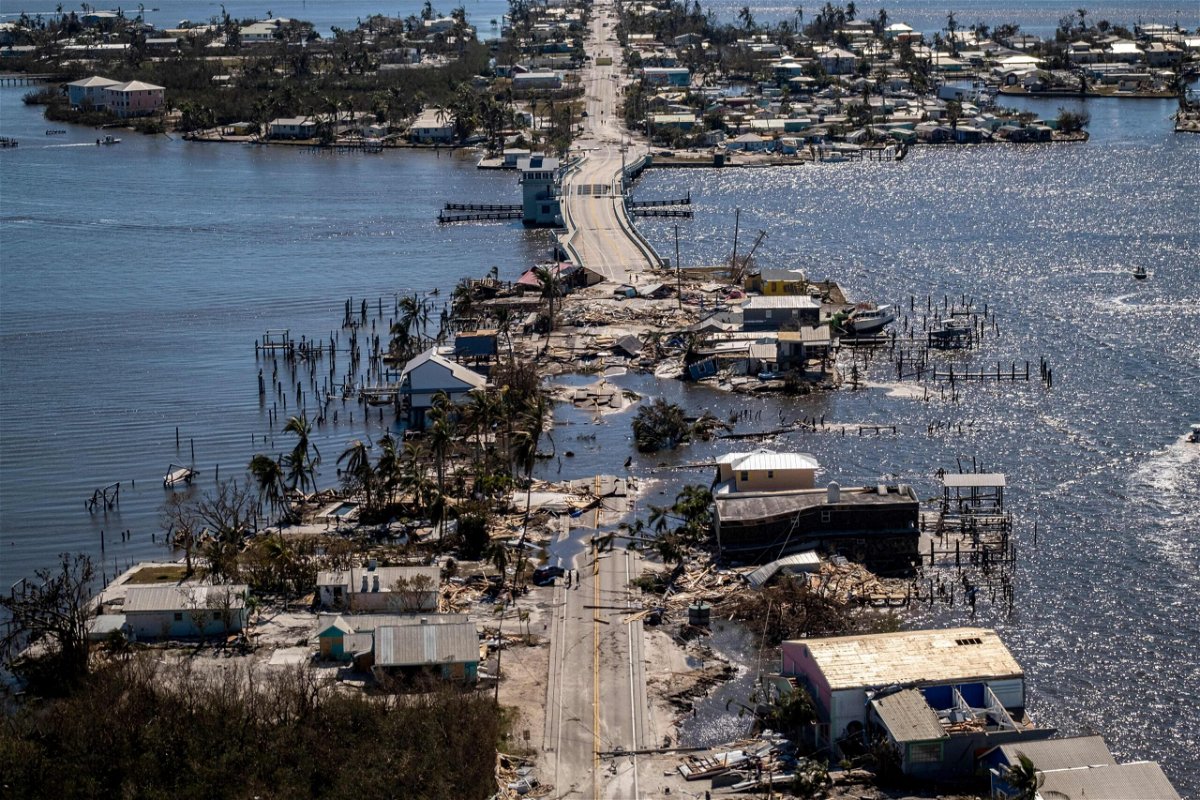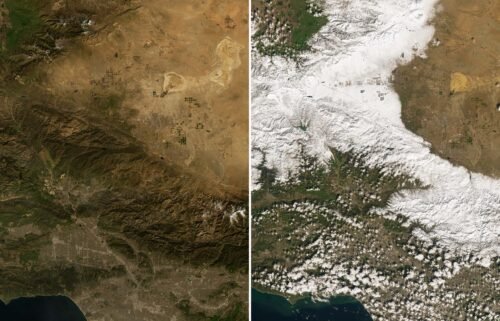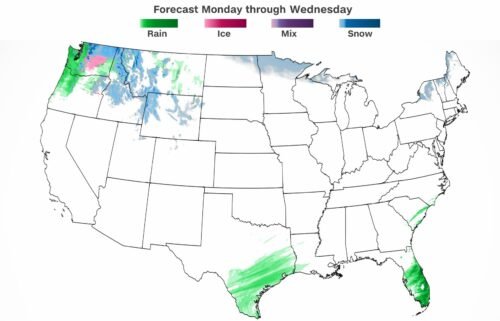Power in parts of Florida could be out for more than a week as flooding lingers in Ian’s wake

An aerial picture taken on Friday shows the only access to the Matlacha neighborhood destroyed in the aftermath of Hurricane Ian in Fort Myers
By Jason Hanna and Aya Elamroussi, CNN
It could be more than a week until power lines are fully restored in some parts of Florida as residents deal with major flooding after the deadly Hurricane Ian, expected to be the most expensive storm in the Sunshine State’s history.
At least 66 people are believed to have died because of Ian in Florida alone, and four people were killed in storm-related incidents in North Carolina, officials say. Ian also knocked out power for hundreds of thousands in the Carolinas Friday into early Saturday.
Eric Silagy, president and CEO of Florida Power & Light Company, said it could take up to a week from Sunday before power is restored in storm-damaged counties. And some customers may not be back on the grid for “weeks or months” because some buildings with structural damage will need safety inspections first.
Meanwhile, river flooding may continue inland well into next week, forecasters warned.
In western Florida’s Arcadia — dozens of miles inland — river flooding still covered part of the town like a lake on Saturday, making a state highway invisible and swallowing all but the roof of a gas station, a CNN crew there saw. Near Sarasota, a possible levee break forced officers to evacuate a neighborhood early Saturday over flooding concerns.
Live updates: Recovery efforts begin in Florida and the Carolinas
In hard-hit Fort Myers, where storm surge swallowed vehicles and many homes’ first levels, Rob Guarino is hosting friends in his high-rise apartment who lost everything.
“A few of them are staying with me now. They just have nowhere to go,” Guarino told CNN’s Boris Sanchez Saturday morning.
By Saturday evening, Ian was a post-tropical cyclone, continuing to weaken across southern Virginia, and it could drop several more inches of rain over parts of West Virginia and western Maryland into Sunday morning, the National Hurricane Center said.
On Wednesday, Ian smashed into southwest Florida as a Category 4 hurricane, pulverizing coastal homes and trapping residents with floodwaters, especially in the Fort Myers and Naples areas. It pushed inland into Thursday, bringing strong winds and damaging flooding to central and northeastern areas.
The hurricane then made another landfall Friday in South Carolina between Charleston and Myrtle Beach as a Category 1 storm, flooding homes and vehicles along the shoreline and eventually knocking out power for hundreds of thousands more in the Carolinas and Virginia.
More than a million customers in Florida still did not have power Saturday evening, and more than 99,000 did not have power in North Carolina, according to poweroutage.us.
‘We can’t hold on anymore’
In Florida’s Fort Myers Beach, where a furious storm surge wiped out homes and left little but debris, shaken survivors are coping with what they saw and mourning those they’ve lost.
Kevin Behen, who rode out the storm on the second floor of a building in Fort Myers Beach, told CNN Friday night he knew of two men who died making sure their wives escaped a home which had begun to flood.
“These guys pushed their wives out the windows to where a tree was,” Behen said. “They just looked at their wives and they said, ‘We can’t hold on anymore. We love you. Bye,’ and that was it.”
About 90% of the island “is pretty much gone,” Fort Myers Beach Town Councilman Dan Allers said Friday. “Unless you have a high-rise condo or a newer concrete home that is built to the same standards today, your house is pretty much gone.”
“I’ve been in this community since the mid-70s, I was on the police department for 25 years, worked a lot of storms, this is by far the worst one I’ve ever seen,” Fort Myers Mayor Kevin Anderson told CNN’s Jim Acosta Saturday evening.
“As tough as this storm is, people are in good spirits and they’re determined not to be defeated,” the mayor added.
Sanibel and Captiva islands, meanwhile, have been cut off from the mainland after parts of a causeway were obliterated by the storm.
Those living in western Florida’s Charlotte County are “facing a tragedy” without homes, electricity or water supplies, said Claudette Smith, public information officer for the sheriff’s office.
“We need everything, to put it plain and simple. We need everything. We need all hands on deck,” Smith told CNN Friday. “The people who have come to our assistance have been tremendously helpful, but we do need everything.”
How to help victims of Hurricane Ian
Further south, in Naples, Brandon and Dylan Barlow were clearing out their grandfather’s flooded home Saturday morning. Dylan, who lives nearby, recalled watching the storm from his own home and realizing a canal by their grandfather was rising too quickly for comfort.
“I didn’t ask him if we could pick him up; I told him we’re picking him up,” Dylan Barlow recalled Saturday. “So we took the car. We got to his house, and by the time we got him out of the house, there was already maybe 2 feet of water.
“And we drove back in the water, and it was very close, but we got him out of there and we got him back to my mom’s house safely.”
Florida areas ‘unrecognizable’
At least 66 deaths suspected to be related to Ian have been reported in Florida, including about 35 in Lee County, according to the sheriff there. The toll also includes 12 in Charlotte County, eight in Collier County, five in Volusia County, three in Sarasota County, one in Polk County, one in Lake County, one in Manatee County, according to officials.
From Florida’s coastal shores to inland cities such as Orlando, dangerous flooding has forced locals into dire circumstances. In one Orlando neighborhood where deep water has covered roads, some residents traveled by boat to assist others.
Local and state officials rescued and evacuated more than 1,070 people from flooded areas in southwest and central Florida and transported 78 people from a flooded elderly care facility, Florida Gov. Ron DeSantis’ office said in a news release Saturday.
The US Coast Guard also performed rescues, according to Rear Adm. Brendan McPherson, but post-storm conditions remained a huge challenge, he told CNN Friday.
“We’re flying and we’re operating in areas that are unrecognizable. There’s no street signs. They don’t look like they used to look like. Buildings that were once benchmarks in the community are no longer there,” he said.
The Coast Guard was also preparing a waterborne operation for Sunday to help people evacuate Pine Island, the Lee County Sheriff’s Office said in a Facebook post.
And in western Florida Saturday, concerns over a possible levee break forced sheriff’s officers to go door-to-door in the Sarasota-area community of Hidden River to warn residents of possible flooding there, the sheriff’s office said.
The problem could pose flooding issues to roughly 70 homes on the east side of the Hidden River neighborhood, the sheriff’s office later added, and encouraged those residents to consider evacuating.
South of Hidden River, about 150 additional people also had to be evacuated because of intruding water in the city of North Port, which already had thousands of flooded homes, Fire Chief Scott Titus said.
Damage in the Carolinas
In North Carolina, four storm-related deaths were reported by Saturday afternoon, the governor’s office said, including a man who drowned when his truck went into a flooded swamp; two people who died in separate crashes; and a man who died of carbon monoxide poisoning after running a generator in a closed garage, the governor’s office said.
No deaths were reported in South Carolina, the governor there said.
The storm has flooded homes and submerged vehicles along South Carolina’s shoreline. Two piers — one in Pawleys Island and another in North Myrtle Beach — partially collapsed as high winds pushed water even higher.
Edgar Stephens, who manages the Cherry Grove Pier in North Myrtle Beach, was steps away when a 100-foot section of the pier crashed into the ocean. The people who own the pier are committed to rebuilding, Stephens said, but it could take months to obtain all the needed materials.
Authorities are also cataloging damage on South Carolina’s Pawleys Island, a coastal town roughly 70 miles north of Charleston. The biggest concern there, according to the mayor, is how to remove debris, so the island can be safe again.
“It was a Category 1 hurricane, but we experienced tremendous storm surge today, probably beyond what most people anticipated,” Mayor Brian Henry told CNN’s Jake Tapper on Friday.
“Most of us did not believe we would see the storm surge at 7-plus feet,” Henry said. “It’s beginning to recede, but we have a huge amount of water on the roadways and across the island.”
Pawleys Island residents are not allowed to return home until safety assessments are fully conducted Saturday, police said.
The-CNN-Wire
™ & © 2022 Cable News Network, Inc., a Warner Bros. Discovery Company. All rights reserved.
CNN’s Andy Rose, Rebekah Riess, Laura James, Amanda Musa, Jamiel Lynch, Ryan Young, Mike Saenz, Joe Sutton, Dave Alsup, Virginia Langmaid, Alaa Elassar, Christina Maxouris, Hannah Sarisohn, Elise Hammond and Seán Federico-O’Murchú contributed to this report.


